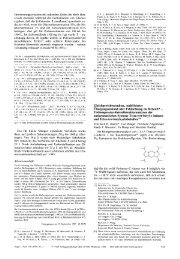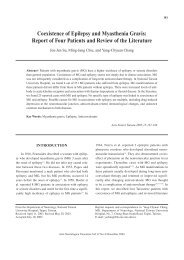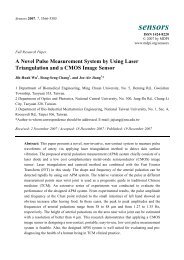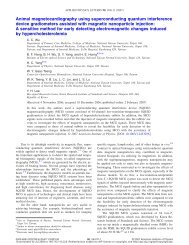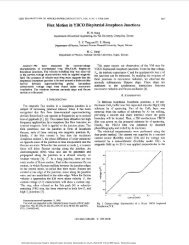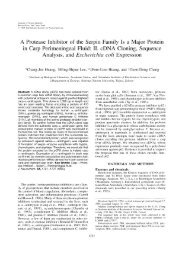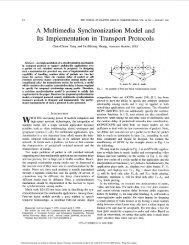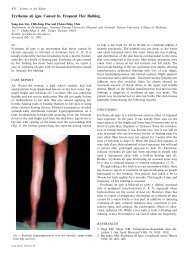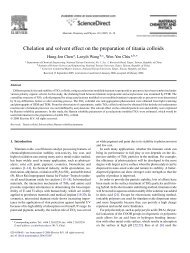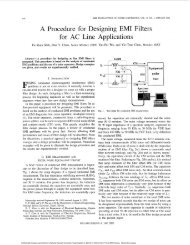Batch Gravitational Sedimentation of Slurries
Batch Gravitational Sedimentation of Slurries
Batch Gravitational Sedimentation of Slurries
You also want an ePaper? Increase the reach of your titles
YUMPU automatically turns print PDFs into web optimized ePapers that Google loves.
FIG. 4—Continued<br />
to the applied compressive pressure. On the other hand, clay<br />
slurries could be compacted more readily to form the sediment<br />
<strong>of</strong> higher solids fraction when φ0 increases (for instance, as<br />
depicted in Figs. 4a– 4e, at 6000 s φ = 0.28 and 0.34 for φ0 =<br />
0.02 and 0.15, respectively). Restated, the clay sediment is more<br />
compressible than is the kaolin sediment.<br />
Quantitative evaluation <strong>of</strong> sediment compressibility requires<br />
the local solid pressure data for the slurries. At equilibrium, the<br />
solid pressure gradient could be stated as follows:<br />
∂ PS<br />
=−ρgφ, [5]<br />
∂t<br />
where ρ is the density difference between the solid and liquid.<br />
Hence, the local solid pressure at height z is expressed as follows:<br />
PS = ρg<br />
0<br />
The solid pressure at bottom (PS|z=0) could be estimated<br />
based on the solids fraction data in Fig. 5 and Eq. [6] with<br />
z = 0. Figures 6a and 6b also represent the estimated PS|z=0<br />
data as functions <strong>of</strong> φ0. All PS|z=0 data at equilibrium are proportional<br />
to φ0, or are equal to the buoyant weight <strong>of</strong> the solid<br />
particles. This also confirms the accuracy <strong>of</strong> the present experimental<br />
measurement.<br />
Local solid pressure data could be evaluated based on Eq. [6].<br />
Figures 7a and 7b illustrate the φ versus PS curves in the final<br />
sediment. Despite certain data scattering, the local solids fraction<br />
decreases continuously with increasing φ0 at some fixed<br />
effective pressure. Comparisons between clay and kaolin slurries<br />
reveal that the former exhibits a more compressible structure<br />
than is the latter.<br />
z<br />
SEDIMENTATION OF SLURRIES 183<br />
φ dz. [6]<br />
The local structure in the sediment would be degraded owing<br />
to gravity consolidation to a level counterbalancing the corresponding<br />
yield stress. Therefore, the φ − PS curves in Fig. 7<br />
represent the φ – Py(φ) correlations. As Fig. 7 reveals, the sediment<br />
yields more readily at the low solids fraction regime than<br />
the high regime. The sediment was consolidated from the gel<br />
point to around 12–15% at a pressure less than 1–2 Pa. At a<br />
higher pressure, the sediment yields more slowly with the applied<br />
pressure. For instance, for kaolin slurry at φ0 = 15% the<br />
solids fraction increases from 15 to 20% over a pressure up to<br />
FIG. 5. The solids fraction distributions in equilibrated sediments.<br />
(a) Kaolin slurry, and (b) clay slurry. Black circles denote the corresponding<br />
null-stress solid fractions.



